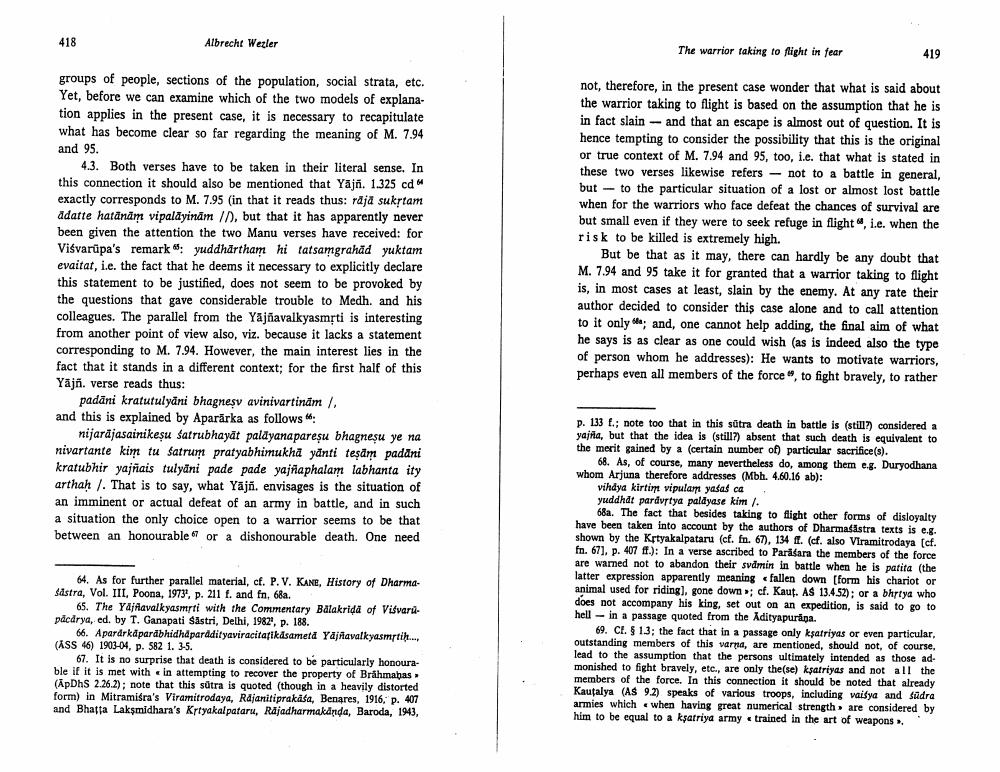________________
418
Albrecht Wezler
groups of people, sections of the population, social strata, etc. Yet, before we can examine which of the two models of explanation applies in the present case, it is necessary to recapitulate what has become clear so far regarding the meaning of M. 7.94 and 95.
4.3. Both verses have to be taken in their literal sense. In this connection it should also be mentioned that Yajñ. 1.325 cd " exactly corresponds to M. 7.95 (in that it reads thus: rājā sukṛtam ädatte hatānām vipaläyinām //), but that it has apparently never been given the attention the two Manu verses have received: for Viśvarupa's remark": yuddhartham hi tatsamgrahad yuktam evaitat, i.e. the fact that he deems it necessary to explicitly declare this statement to be justified, does not seem to be provoked by the questions that gave considerable trouble to Medh. and his colleagues. The parallel from the Yajnavalkyasmṛti is interesting from another point of view also, viz. because it lacks a statement corresponding to M. 7.94. However, the main interest lies in the fact that it stands in a different context; for the first half of this Yājñ. verse reads thus:
padāni kratutulyani bhagneṣv avinivartinām /, and this is explained by Apararka as follows":
nijarajasainikeṣu satrubhayat palayanapareşu bhagneşu ye na nivartante kim tu satrum pratyabhimukha yanti teşäm padāni kratubhir yajñais tulyäni pade pade yajñaphalam labhanta ity arthaḥ /. That is to say, what Yajñ. envisages is the situation of an imminent or actual defeat of an army in battle, and in such a situation the only choice open to a warrior seems to be that between an honourable or a dishonourable death. One need
64. As for further parallel material, cf. P. V. KANE, History of DharmaSastra, Vol. III, Poona, 1973, p. 211 f. and fn, 68a.
65. The Yajnavalkyasmrti with the Commentary Balakriḍā of Visvarapācārya, ed. by T. Ganapati Săstri, Delhi, 1982, p. 188.
66. Aparärkäparābhidhäparadityaviracitațikäsametä Yajnavalkyasmṛtiḥ.... (ASS 46) 1903-04, p. 582 1. 3-5.
67. It is no surprise that death is considered to be particularly honourable if it is met with in attempting to recover the property of Brahmahas (ApDhS 2.26.2); note that this sütra is quoted (though in a heavily distorted form) in Mitramiśra's Viramitrodaya, Rajanitiprakasa, Benares, 1916, p. 407 and Bhatta Laksmidhara's Krtyakalpataru, Rajadharmakanda, Baroda, 1943,
The warrior taking to flight in fear
not, therefore, in the present case wonder that what is said about the warrior taking to flight is based on the assumption that he is in fact slain and that an escape is almost out of question. It is hence tempting to consider the possibility that this is the original or true context of M. 7.94 and 95, too, i.e. that what is stated in these two verses likewise refers not to a battle in general, but to the particular situation of a lost or almost lost battle when for the warriors who face defeat the chances of survival are but small even if they were to seek refuge in flight", i.e. when the risk to be killed is extremely high.
419
But be that as it may, there can hardly be any doubt that M. 7.94 and 95 take it for granted that a warrior taking to flight is, in most cases at least, slain by the enemy. At any rate their author decided to consider this case alone and to call attention. to it only; and, one cannot help adding, the final aim of what he says is as clear as one could wish (as is indeed also the type of person whom he addresses): He wants to motivate warriors, perhaps even all members of the force", to fight bravely, to rather
p. 133 f.; note too that in this sutra death in battle is (still?) considered a yajña, but that the idea is (still?) absent that such death is equivalent to the merit gained by a (certain number of) particular sacrifice(s).
68. As, of course, many nevertheless do, among them e.g. Duryodhana whom Arjuna therefore addresses (Mbh. 4.60.16 ab):
vihdya kirtim vipulam yasas ca
yuddhat parávṛtya palayase kim /.
68a. The fact that besides taking to flight other forms of disloyalty have been taken into account by the authors of Dharmasastra texts is e.g. shown by the Krtyakalpataru (cf. fn. 67), 134 fl. (cf. also Viramitrodaya [cf. fn. 671, p. 407 ff.): In a verse ascribed to Parādara the members of the force are warned not to abandon their svämin in battle when he is patita (the latter expression apparently meaning fallen down [form his chariot or animal used for riding], gone down; cf. Kaut. AS 13.4.52); or a bhrtya who does not accompany his king, set out on an expedition, is said to go to hell in a passage quoted from the Adityapurāna.
69. Cf. § 1.3; the fact that in a passage only ksatriyas or even particular, outstanding members of this varna, are mentioned, should not, of course, lead to the assumption that the persons ultimately intended as those admonished to fight bravely, etc., are only the(se) ksatriyas and not all the members of the force. In this connection it should be noted that already Kautalya (AS 9.2) speaks of various troops, including vaisya and sūdra armies which when having great numerical strength are considered by him to be equal to a ksatriya army trained in the art of weapons ».




